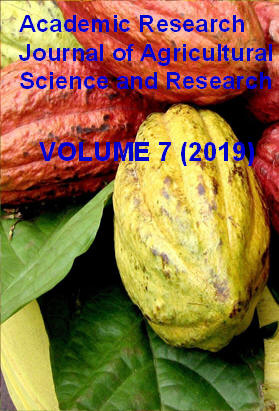|
ISSN: 2360-7874 |
Academic Research Journal of
Agricultural Science and Research |
|||||||||||||||||||
|
Vol. 7(7), pp. 484-492, November 2019 Research Physiological and Biochemical Changes in Certain Angiosperm Plants in Reference to Host- Parasite (Cuscuta Spp) Interaction: An Overview
Danish Inam and Sanjay Mishra*
School of Biotechnology, IFTM University, Delhi Road ( NH-24) , Moradabad -244102, UP, India *Corresponding Author: (Dr. Sanjay Mishra). Email: sanjaymishra@iftmuniversity.ac.in
Accepted 11 November 2019
As compared with plant–microbe interaction, little is identified about the interaction of parasitic plants with their hosts. Therefore, the present overview has been aimed to provide certain cues to researchers working to explore interactions between angiospermic parasites like Cuscuta and their hosts in view of development of platform for advancement in agronomic management. Cuscuta plants belonging to Cuscutaceae family comprise about 200 species, all of which survive as stem holoparasites on other plants. Cuscuta spp. possesses neither roots nor fully expanded leaves and the vegetative portion appears to be a stem only. The parasite winds around host plants and penetrates stems via haustoria, forming direct connections to the vascular bundles of their hosts to withdraw water, carbohydrates, and other solutes. Transpiration is a key process regulating solute transfer from host to parasite. The haustorium appears to play a role in regulating solute composition, and thus angiosperm plants are badly affected by certain plant parasites like Cuscuta spp. Upon infection by host plants, certain physiological and biochemical changes occur, affecting the quality and quantity of yield from angiosperm plants. Besides susceptible hosts, a few plants exhibit an active resistance against infestation by Cuscuta spp. For example, cultivated tomato (Solanum lycopersicum) fends off Cuscuta reflexa by means of a hypersensitive-type response occurring in the early penetration phase. Host responses to infection are comprehensively reviewed focusing on angiosperm plants in reference to host- parasite (Cuscuta spp.) interaction. It is concluded that competition for water and solutes are unlikely to play a major role in determining reduction in host productivity as a consequence of metabolic incompatibility, suggested to be the major cause of this happening. Nevertheless, this article may provide new insights into developing biochemical strategies for overcoming agricultural perturbation of crop yield.
Key words: Agricultural perturbation; angiosperm plants; Cuscuta spp, host- parasite interaction; haustoria
How to cite this article (APA Style): Danish I., Sanjay M (2019). Physiological and Biochemical Changes in Certain Angiosperm Plants in Reference to Host- Parasite (Cuscuta Spp) Interaction: An Overview. Acad. Res. J. Agri. Sci. Res. 7(7): 484-492
|
|||||||||||||||||||
